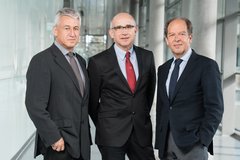In the 2012 established CRC, physicians and scientists together explore the origin and personalized treatment of leukemia: basic research and clinical application go hand in hand. “The renewed funding of our Collaborative Research Center SFB 1074 shows that the leukemia research at Ulm Univeristy occupies an internationally leading position. With the first funding’s research projects we have contributed in groundbreaking findings not only for the research of the pathogenesis of leukemia, but also for better treatment of the disease,” says Professor Hartmut Döhner, Coordinating Investigator of the CRC and Medical Director of the University Hospital’s Department of Internal Medicine III.
Joint Research for a Big Goal
In the CRC more than 20 leading scientists from various disciplines in a total of 16 projects research for a common goal: Through a better understanding of the genetic changes in leukemia, targeted and “tailored” therapies are to be developed. The focus is on the most common acute and chronic leukemias occurring predominantly at an advanced age and which frequently end fatally. Using experimental models, the researchers investigate at the cellular and molecular level how leukemias arise. By doing so they strive to target new drugs. Furthermore, the Ulm biobank allows them to look for genetic and epigenetic abnormalities in various blood cancers. In two central projects, the physicians and scientists devote themselves to novel study methods such as DNA sequencing and protein analysis techniques.
Development of New Treatment Options
Among the biggest successes of the first funding period’s basic research is the description of a previously unknown aging and “rejuvenating” mechanism of hematopoietic stem cells. The scientists were able to show that by blocking a certain protein substance older stem cells are able to repair themselves more efficiently. Furthermore, researchers have characterized typical genetic lesions in the most common forms of leukemia in adults, acute myeloid leukemia and chronic lymphocytic leukemia, and uncovered the genetic basis of resistance mechanisms against new leukemia drugs. “The special feature of our research group is the transfer of basic research into clinical applications. Our mission is the development of new treatment options. Our patients should be spared therapeutic failures and related side effects”, says Professor Klaus-Michael Debatin, deputy CRC Spokesperson and Medical Director of the University Hospital’s Department of Pediatrics and Adolescent Medicine. Research results have been published in prestigious journals such as “Nature” or the “New England Journal of Medicine”, adds the Vice President of Medicine, Gender and Diversity.
Excellent Conditions in Ulm
The conditions of Ulm University´s medicine are excellent: Researchers have access to experimental leukemia models and countless blood and bone marrow samples – Ulm’s leukemia Biobank is among the most comprehensive in the world. Leukemia patients benefit directly from findings of the Collaborative Research Center at the Comprehensive Cancer Center Ulm (CCCU), which was again awarded by the German Cancer Aid as ” Oncological Center of Excellence”.
Source: Ulm University
